
James Wells' M.A.D.
(M.A.D. Mark II)
(#208)
In December 2006, Ken Kramer delivered a second Motorized
Ascending Device. James Wells made this M.A.D. using blueprints
obtained from Nevin Davis in the early 1970s. James donated the
MAD to my collection via other cavers, and it took a while for
it to arrive at my house, passing from one caver to another over
many months. Until it arrived, I did not know that a second M.A.D.
existed.
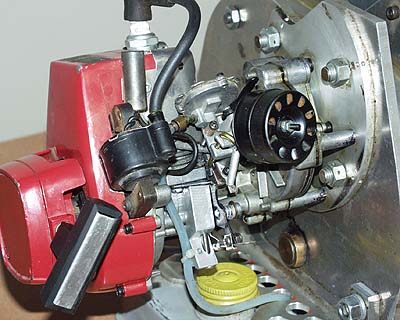 When
Ken and I opened the box containing Wells' M.A.D., we noticed
that it was not complete. Most of the work had been finished,
but the throttle assembly had not been attached. Nevin's original
MAD had a motor-cycle grip throttle, but he later replaced it
with a smaller and lighter handgrip. James had parts for a grip
throttle, so I decided to use them to complete his M.A.D. I used
my lathe to make a mounting post to attach a motorcycle grip throttle
and a kill switch to the right side of the M.A.D. I also milled
a bracket for attaching the other end of the throttle cable to
the engine. You can see this bracket just above the yellow fuel
cap in the photo.
When
Ken and I opened the box containing Wells' M.A.D., we noticed
that it was not complete. Most of the work had been finished,
but the throttle assembly had not been attached. Nevin's original
MAD had a motor-cycle grip throttle, but he later replaced it
with a smaller and lighter handgrip. James had parts for a grip
throttle, so I decided to use them to complete his M.A.D. I used
my lathe to make a mounting post to attach a motorcycle grip throttle
and a kill switch to the right side of the M.A.D. I also milled
a bracket for attaching the other end of the throttle cable to
the engine. You can see this bracket just above the yellow fuel
cap in the photo.
Ken and I found a broken gear in the parts that came with this
M.A.D., and also found a box and receipt for a replacement part.
We assume that James had started the engine on his M.A.D., and
that it had failed. For this reason, I have not tried to restart
the engine.
This M.A.D. is 315 mm. tall, 455 mm. wide, 285 mm. thick, and weighs 10800 g. Since this MAD followed Nevin's blueprints, there are many
similarities, but some differences as well. I decided to describe
Wells' M.A.D. using photographs of the two versions sitting side
by side.
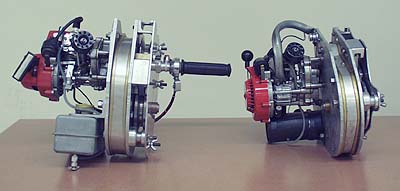
The rear view shows what the user sees. The most apparent difference
is the motorcycle handgrip sticking out from the right side of
Wells' M.A.D. James included a copy
of Nevin's blueprint for the M.A.D., as well as a number of
photographs. Some of these showed the original motorcycle grip
design, which differed from my design completion in several ways.
Nevin's original design had a second handlebar sticking out on
the left, but I did not include this when I finished Wells' ascender.
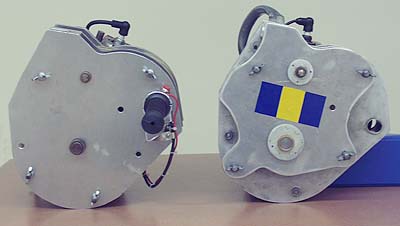
Here we see the right side of the two ascenders. As you can
see, Nevin removed some excess material from the cover plate to
lighten the ascender. James' version is about 400 g heavier
than Nevin's, part of which is due to using a different engine
and a larger fuel tank. Such a small weight difference is not
important. Another difference is that Nevin put bushings on his
cover plate to help support the two gear shaft bearings. I did
not bother adding these when I completed the Wells M.A.D.
The large hole on the right side of Nevin's ascender is where
he located his handlebars.
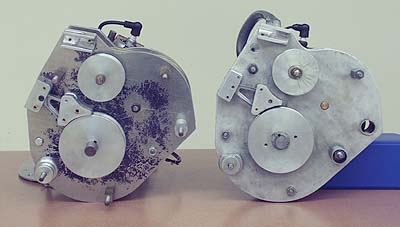
Right Side, cover removed:
Well's Second M.A.D., Davis' Original
M.A.D.
Here are the two ascenders with the cover plates removed. Wells'
still has Dykem from the layout process; I haven't taken time
to remove it. As expected, the internal working of the two are
similar.
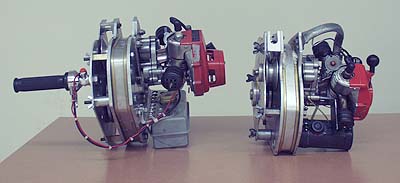
This shows the front view of the two ascenders. (The views
are not quite equivalent because James' M.A.D. has a larger, rectangular
gas tank that holds his M.A.D. in a more upright position than
Nevin's). From this angle, you can see why I chose not to add
a left-hand handlebar to Wells' M.A.D. - sitting in front of the
engine, it would have had to stick out very far to the side.
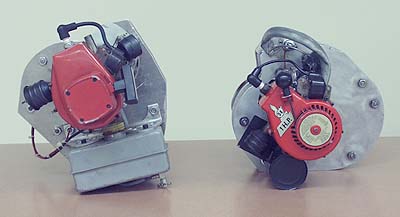
James and Nevin used different brand engines, but they are
both small, integral clutch models. James' uses a much larger fuel
tank than Nevin's. When comparing the photos, remember that the
rectangular gas tank holds James' M.A.D. in a more upright position
than Nevin's.

For far more content, use a larger monitor and a full-width window.
Hundreds of cell phone users complained and asked me to for a simpler, mobile friendly site. In particular, they wanted me to limit each page to a small number of pictures and minimize my use of text. This new site provides what they asked for.

